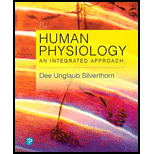
Concept explainers
To determine: The process that occurs when epinephrine combines with β1-receptors in the heart.
Introduction: The nervous system is the organ system that produces responses against environmental stimuli. The cells that transmit information about the environmental changes to the brain are called nerve cells or neurons. The neurons release many chemicals and hormones. The chemicals secreted by the nerve cells are called neurotransmitters.
To determine: The phenomenon that takes place when epinephrine combines with β2-receptors in the heart.
Introduction: Epinephrine is a hormone that is secreted by the nerve cells. It is also called adrenaline. The body produces this neurotransmitter only in stressful conditions. The cardiac muscles of the heart are composed of myocardial cells. These cells have two types of receptors. These are β1-receptor and β2-receptor.
To determine: The heart tissue that possesses different types of β-receptors.
Introduction: All the cells of the body require oxygen to produce energy. The blood provides oxygen to the cells. The circulatory system is a well-defined system of the body that supplies oxygen-rich blood to all the cells. Heart is the most vital part of the circulatory system.
Want to see the full answer?
Check out a sample textbook solution
Chapter 15 Solutions
Human Physiology: An Integrated Approach (8th Edition)
- please draw in the answers, thank youarrow_forwarda. On this first grid, assume that the DNA and RNA templates are read left to right. DNA DNA mRNA codon tRNA anticodon polypeptide _strand strand C с A T G A U G C A TRP b. Now do this AGAIN assuming that the DNA and RNA templates are read right to left. DNA DNA strand strand C mRNA codon tRNA anticodon polypeptide 0 A T G A U G с A TRParrow_forwardplease answer all question below with the following answer choice, thank you!arrow_forward
- please draw in the answeres, thank youarrow_forwardA) What is being shown here?B) What is indicated by the RED arrow?C) What is indicated by the BLUE arrow?arrow_forwardPlease identify the curve shown below. What does this curve represent? Please identify A, B, C, D, and E (the orange oval). What is occurring in these regions?arrow_forward
- Please identify the test shown here. 1) What is the test? 2) What does the test indicate? How is it performed? What is CX? 3) Why might the test be performed in a clinical setting? GEN CZ CX CPZ PTZ CACarrow_forwardDetermine how much ATP would a cell produce when using fermentation of a 50 mM glucose solution?arrow_forwardDetermine how much ATP would a cell produce when using aerobic respiration of a 7 mM glucose solution?arrow_forward
 Biology: The Unity and Diversity of Life (MindTap...BiologyISBN:9781305073951Author:Cecie Starr, Ralph Taggart, Christine Evers, Lisa StarrPublisher:Cengage Learning
Biology: The Unity and Diversity of Life (MindTap...BiologyISBN:9781305073951Author:Cecie Starr, Ralph Taggart, Christine Evers, Lisa StarrPublisher:Cengage Learning Principles Of Radiographic Imaging: An Art And A ...Health & NutritionISBN:9781337711067Author:Richard R. Carlton, Arlene M. Adler, Vesna BalacPublisher:Cengage Learning
Principles Of Radiographic Imaging: An Art And A ...Health & NutritionISBN:9781337711067Author:Richard R. Carlton, Arlene M. Adler, Vesna BalacPublisher:Cengage Learning





